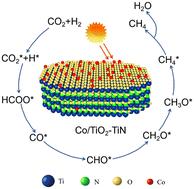A Co-nanoparticle/layered TiO2–TiN composite for selective photothermocatalytic reduction of CO2 to CH4†
IF 4.2
3区 化学
Q2 CHEMISTRY, PHYSICAL
引用次数: 0
Abstract
Photothermocatalytic carbon dioxide (CO2) reduction into value-added chemicals is one of the promising methods for solar-to-chemical energy conversion. However, the improvement of catalytic activity and product selectivity remain a challenge in view of practical applications. Herein, we report a facile “two-step” approach – nitrogen treatment of Ti3C2 MXene (TC) and loading of Co nanoparticles – to synthesize a Co-nanoparticle/layered TiO2–TiN composite as an efficient photothermocatalyst for selective reduction of CO2 to methane (CH4). The optimal 35Co/TiO2–TiN catalyst exhibits a 62.8% CO2 conversion ratio with a CH4 evolution rate of 45.5 mmol gcat−1 h−1 and 99.3% selectivity under 300 W xenon lamp irradiation for 60 min. In contrast, the Co/Ti3C2 catalyst shows a high selectivity toward CO production. The synergistic effect of increased light absorption capacity, reactive sites, CO2 adsorption/activation ability, and desorption energy barrier of the CO* intermediate by the loaded Co nanoparticles and the formation of Ti–N–O bonds could account for the significantly enhanced photothermocatalytic performance of 35Co/TiO2–TiN for selective CO2 reduction into CH4. Our work demonstrates that metal nanoparticle loading and formation of Ti–N–O bonds can be integrated into the strategy in developing a photothermocatalyst for efficient CO2 reduction with controlled product selectivity.

co -纳米颗粒/层状TiO2-TiN复合材料用于选择性光热催化CO2还原为CH4†
光热催化二氧化碳(CO2)还原成增值化学品是一种很有前途的太阳能-化学能转换方法。然而,从实际应用的角度来看,提高催化活性和产物选择性仍然是一个挑战。在此,我们报告了一种简单的“两步”方法- Ti3C2 MXene (TC)的氮处理和Co纳米颗粒的负载-合成Co纳米颗粒/层状TiO2-TiN复合材料,作为一种有效的光热催化剂,选择性地将CO2还原为甲烷(CH4)。最佳35Co/ TiO2-TiN催化剂在300 W氙灯照射60 min下,CO2转化率为62.8%,CH4析出率为45.5 mmol gcat−1 h−1,选择性为99.3%。相比之下,Co/Ti3C2催化剂对Co的生成具有较高的选择性。负载的CO纳米颗粒增加了CO*中间体的光吸收能力、反应位、CO2吸附/活化能力和解吸能垒,并形成了Ti-N-O键,这是35Co/ TiO2-TiN选择性将CO2还原为CH4的光热催化性能显著增强的原因。我们的工作表明,金属纳米颗粒的负载和Ti-N-O键的形成可以整合到开发光热催化剂的策略中,以控制产物选择性,有效地减少二氧化碳。
本文章由计算机程序翻译,如有差异,请以英文原文为准。
求助全文
约1分钟内获得全文
求助全文
来源期刊

Catalysis Science & Technology
CHEMISTRY, PHYSICAL-
CiteScore
8.70
自引率
6.00%
发文量
587
审稿时长
1.5 months
期刊介绍:
A multidisciplinary journal focusing on cutting edge research across all fundamental science and technological aspects of catalysis.
Editor-in-chief: Bert Weckhuysen
Impact factor: 5.0
Time to first decision (peer reviewed only): 31 days
 求助内容:
求助内容: 应助结果提醒方式:
应助结果提醒方式:


